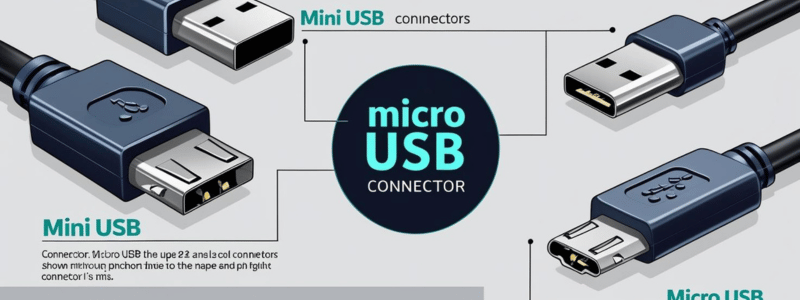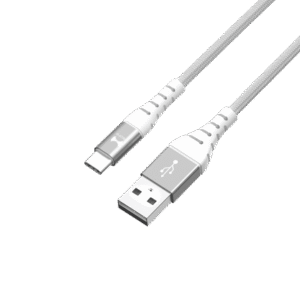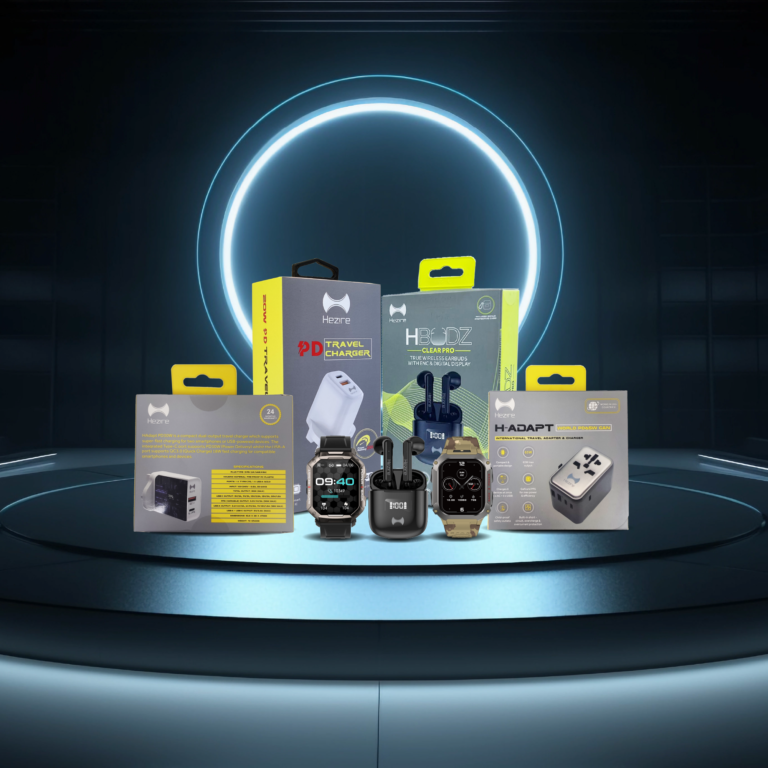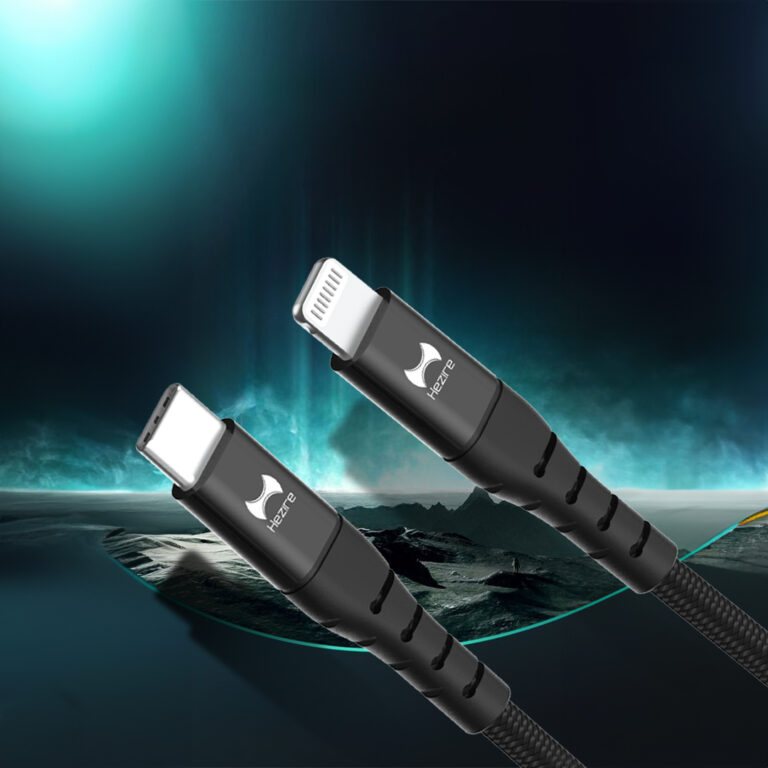
Mini USB and Micro USB connectors may seem similar, but they serve distinct purposes. Choosing the wrong connector can render it useless for your intended application. This guide explains the key differences between Mini USB and Micro USB, helping you select the right one for your needs.

- Select options This product has multiple variants. The options may be chosen on the product page
Hezire HCable

- Select options This product has multiple variants. The options may be chosen on the product page
H-Cable PRO
Mini USB: The Original Standard
- Overview: Mini USB, introduced in the early 2000s, was one of the first USB connector variations. It features a five-pin design with two crimped edges, forming a trapezoid shape.
- Common Uses: Initially popular in MP3 players and point-and-shoot digital cameras.
- Current Status:
- Mini USB is now less common, used by only a few devices.
- While not outdated, Mini USB cables are harder to find in big-box stores and may need to be ordered online.
- It remains significant as a milestone in the history of USB technology.
Micro USB: The Modern Standard
- Overview: Micro USB, also known as Micro-B, emerged later as a streamlined, thinner version of the Mini USB connector with a five-pin configuration.
- Purpose: Designed to standardize connectors for Android mobile devices, Micro USB became the go-to choice for charging and data transfer.
- Advantages:
- Offers charging and data transmission rates equal to or better than Mini USB.
- Widely adopted as the standard for Android phones and other devices for many years.
- Micro USB cables and accessories remain widely available.
- Industry Trend: Mobile manufacturers have largely agreed to use Micro USB for communication and charging, making it the preferred choice for modern mobile devices.
Mini USB vs. Micro USB: Key Comparisons
Feature | Mini USB | Micro USB |
Introduced | Early 2000s | Later, post-Mini USB |
Shape | Trapezoid with crimped edges | Thinner, streamlined design |
Pin Configuration | 5-pin | 5-pin |
Common Devices | MP3 players, older cameras | Android phones, modern devices |
Availability | Less common, often online-only | Widely available |
Standardization | Broad compatibility with older devices | Industry standard for mobile devices |
- Compatibility: Mini USB is compatible with a wider range of older devices, but Micro USB is favored in current and emerging technologies, especially mobile phones.
- Future Outlook: Micro USB is poised to remain the primary USB connector for mobile devices due to industry standardization.
Choosing a Reliable USB Cable Supplier
To maximize your investment in USB cables, select a supplier that offers:
- Competitive Pricing: Look for fair and affordable pricing to get the best value.
- High Quality: Choose companies that provide top-brand cables for durability and performance.
- Excellent Customer Service: Opt for suppliers known for responsive and reliable support.
A trusted leader in the industry, Hezire exemplifies these qualities. Based in the UAE, Hezire is renowned for:
- Competitive prices.
- High-quality USB cables, including Micro USB options.
- Exceptional customer service with every transaction.
Why Choose Hezire for USB Cables?
Hezire offers a wide selection of high-quality USB cables, with a focus on Micro USB cables, which are the most popular choice today. Their product range includes top-performing cables like the HCable Prime USB-A to Micro USB Charge & Sync Cable (1.2m, Black).
- Affordability: Hezire’s cables are reasonably priced, making them an excellent value.
- Versatility: Pair their cables with the best power banks for optimal performance (learn more).
- Reliability: Hezire ensures a seamless purchasing experience with a diverse product lineup and top-notch support.
Get Started with Hezire Today
A high-quality USB cable is an essential accessory for modern devices. Don’t settle for less—choose Hezire for the best Micro USB cables at competitive prices. Contact Hezire today to explore their offerings and enjoy reliable, high-performance USB connections.
FAQS
A mini USB is a small, rectangular connector slightly larger than a micro USB. It typically has a trapezoid shape with a wider top and narrower bottom, featuring five pins inside. It was commonly used for older digital cameras, MP3 players, and some smartphones before micro USB became the standard.
.
Mini USB ports were commonly used in older electronic devices before micro USB and USB-C became standard. They can be found in older digital cameras, MP3 players, GPS units, external hard drives, some mobile phones, and portable game consoles. These ports are mainly used for charging and data transfer.
The main difference between USB Mini and USB Micro is their size and usage. USB Mini connectors are slightly larger and were commonly used in older devices like cameras and MP3 players. USB Micro connectors are smaller, more durable, and became the standard for most smartphones, tablets, and modern gadgets before USB-C. Micro USB ports are also designed to last longer with more insertion cycles compared to Mini USB.
The USB symbol is a small trident-shaped icon found on USB cables, ports, and devices. It represents the versatility of USB technology, with each branch of the trident symbolizing different types of connections (power, data, and other functions). This symbol helps users easily identify USB-compatible ports and connectors.




I always mix up Mini and Micro USB. This was super helpful
This will definitely come in handy when I need to replace cables!
I had no idea Micro USB was so much smaller than Mini USB!
Thanks for simplifying the technical jargon around USB connectors!
I always get a little confused when it comes to different types of USB cables. Which one is right for me? Thanks for clearing things up!
I can never tell the difference between USB cables—this helped a lot!
Car Mobile Chargers & Holders This product is a game-changer, love it! https://hezire.com/product-category/cables/
Your point of view caught my eye and was very interesting. Thanks. I have a question for you.
Superb quality, worth every penny!
Superb quality, worth every penny!
Such a well-written article, really enjoyed it!
Great product, will definitely buy again!
This product is top-notch, very satisfied
Actual watch news and events. Latest collections, models. Up to date information about old watch houses.
https://chrono.luxepodium.com/
Such a well-written article, really enjoyed it
Such a well-written article, really enjoyed it
recently bought this product tablet Online https://hezire.com/product/hbook-prime-8-inch-4g-simwifi-tablet-with-folio-cover/ is a game-changer, love it!
Superb quality, worth every penny!
Incredibly useful tips, thanks for posting!
Incredibly useful tips, thanks for posting!
Works perfectly, I’m so happy with this purchase!
Works perfectly, I’m so happy with this purchase!
recently bought this product tablet Online https://hezire.com/product/hbook-prime-8-inch-4g-simwifi-tablet-with-folio-cover/ is a game-changer, love it!
recently bought this product tablet Online https://hezire.com/product/hbook-prime-8-inch-4g-simwifi-tablet-with-folio-cover/ is a game-changer, love it!
Works perfectly, I’m so happy with this purchase!
This product is a game-changer, love it
This product is a game-changer, love it
Just got these true wireless earbuds, and they’re fantastic—great sound and super comfortable! https://hezire.com/product/hezire-hbudz-smart-true-wireless-earbuds-with-anc-enc-app-white/
nice
recently bought this product Smart Watches Online Amazing product quality, worth every penny! From hezire https://hezire.com/product/hezire-h-watch-commando-desert-camo/
Awesome content, keep up the good work!
Just got this and I’m already a huge fan!https://hezire.com/product/hezire-h-sound-neon-wireless-bluetooth-speaker-with-led-lights-fm-radio/
Just got this and I’m already a huge fan!https://hezire.com/product/hezire-h-sound-neon-wireless-bluetooth-speaker-with-led-lights-fm-radio/
Just got this and I’m already a huge fan!https://hezire.com/product/hezire-h-sound-neon-wireless-bluetooth-speaker-with-led-lights-fm-radio/
Just got this and I’m already a huge fan!https://hezire.com/product/hezire-h-sound-neon-wireless-bluetooth-speaker-with-led-lights-fm-radio/
Just got this and I’m already a huge fan!https://hezire.com/product/hezire-h-sound-neon-wireless-bluetooth-speaker-with-led-lights-fm-radio/
Loving this product, it’s been a great addition https://hezire.com/product/hezire-hbudz-clear-pro-true-wireless-earbuds-with-digital-display-black-hez-tws-155/
Loving this product, it’s been a great addition https://hezire.com/product/hezire-hbudz-clear-pro-true-wireless-earbuds-with-digital-display-black-hez-tws-155/
Loving this product, it’s been a great addition https://hezire.com/product/hezire-hbudz-clear-pro-true-wireless-earbuds-with-digital-display-black-hez-tws-155/
Shop Wireless Headphones Online https://hezire.com/product/hezire-hbudz-clear-pro-true-wireless-earbuds-with-digital-display-black-hez-tws-155/
Shop Wireless Headphones Online https://hezire.com/product/hezire-hbudz-clear-pro-true-wireless-earbuds-with-digital-display-black-hez-tws-155/
This purchase was a great decision, highly impressed! https://hezire.com/product-category/wearables/
BEST PRODUCT H-Band VOICE Wireless Neckband Headset with A.I Voice Control https://hezire.com/product/hezire-h-band-voice-wireless-neckband-headset-with-a-i-voice-control-blue/
A handy guide for understanding which USB type I need!
This clears up why some of my cables don’t fit my devices. Thanks.
Super useful info for anyone who works with older tech! Thanks.
Didn’t know Mini USB was larger than Micro USB. Thanks for the info!
Mini USB vs Micro USB—finally explained in a way that makes sense!
Thanks for explaining the size and function differences between Mini and Micro USB!
I had no idea Mini USB was still used in some devices! Thanks for the info!
Great breakdown of the differences between these two USB connectors!
Perfect article!
Nice content.
This post clears up the confusion I had about Mini USB vs Micro USB!
Great explanation of the differences! It’s helpful to know which type of USB is best suited for specific devices.
Loved how easy this was to understand. Amazing read!
Such a clear and concise article—really liked it!
Wow, I always wondered about the differences. Thanks for this great read!
Awesome article! Now I know which USB connector I’ve been using all along.
Great explanation! Loved how clearly the distinctions were laid out.
Wow, this was such an insightful read! Finally understand the differences—thank you!
I don’t think the title of your article matches the content lol. Just kidding, mainly because I had some doubts after reading the article.
This was such an informative read! It’s amazing how small design changes can make such a big difference in functionality.